The Economics and Statistics Division maintains archives of previous publications for accountability purposes, but makes no updates to keep these documents current with the latest data revisions from Statistics Canada. As a result, information in older documents may not be accurate. Please exercise caution when referring to older documents. For the latest information and historical data, please contact the individual listed to the right.
<--- Return to Archive
For additional information relating to this article, please contact:
January 28, 2019NON-RESIDENTIAL CAPITAL STOCK REMAINING SERVICE LIFE, 2016 Statistics Canada released data on the age of the non-residential capital stock in the provinces. The assets are measured by the "remaining useful service life of non-residential capital stock" which is estimated as a percentage of service life remaining relative to the total service life of the asset. It is measured as the ratio of the average asset age to its expected service life. Changes to the remaining useful service life can come from changes in the investment level or in the investment mix.
CANADA AND PROVINCES
In 2016, the average age of the non-residential capital stock was 9.8 years in Nova Scotia compared to 8.5 years in Canada. The oldest capital stock was in Prince Edward Island (10.0 years) and the youngest in Saskatchewan (7.8 years). Compared to 2009, the average age of the non-residential capital stock is little change (+0.1 years) in Nova Scotia. The age of the capital stock has been rising the most in Prince Edward Island and New Brunswick since 2009. The age of the capital stock declined by the most for Newfoundland and Labrador.
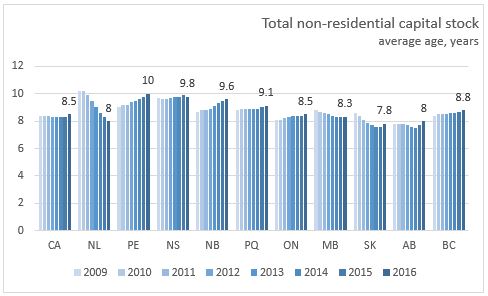
The remaining useful service life ratio for the non-residential capital stock in Nova Scotia was up by 0.3 percentage points to 58.5 per cent in 2016. Nova Scotia has the second lowest remaining service life ratio among the provinces after Prince Edward Island. Canada's remaining service life ratio was down 0.4 percentage points to 65.7 per cent in 2016 with declines in seven provinces.
Since 2009, the remaining useful service life ratio in Nova Scotia has increased by 0.9 percentage points. From 2009 to 2016, the remaining service life ratios had the greatest increases in Newfoundland and Labrador, Manitoba, and Saskatchewan. Smaller increases occurred in Quebec, Ontario, Alberta and British Columbia while Prince Edward Island and New Brunswick saw declines.

Among asset classes, the remaining service life ratio of buildings has seen little change in Canada since 2009 with a 0.5 percentage increase. Building's remaining useful service life ratios rose in all provinces since 2009 except for Prince Edward Island, Ontario and British Columbia.
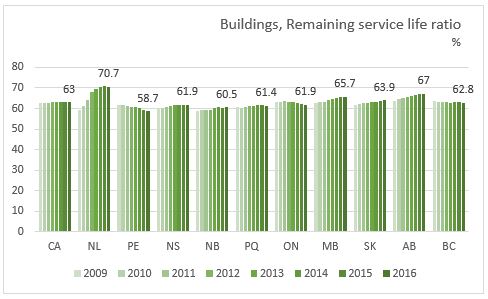
The remaining service life for engineering assets strongly increased in Newfoundland and Labrador (+11.9 pp), Manitoba (+6.6 pp), Saskatchewan (+2.8 pp), and Ontario (+3.2 pp) since 2009. Declines in the ratio occurred in all the Maritime provinces. Alberta, Newfoundland and Labrador, Saskatchewan, and Manitoba have the highest remaining service life ratios for engineering assets.

The remaining useful service life ratio for machinery and equipment in Canada was down 0.4 percentage points over the 2009 to 2016 period. Nova Scotia's ratio was up 5.5 percentage points since 2009, tied with Saskatchewan for the largest increase in this category.
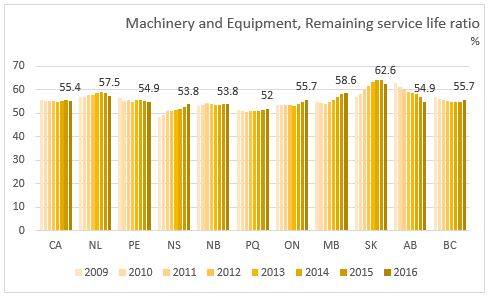
The remaining service life ratio for intellectual property products declined for both Canada and Nova Scotia over 2009 to 2016 period. Nova Scotia had a notable 3.4 percentage points incrase in 2016. Most provinces saw declines in the ratio since 2009 with the exception of Newfoundland and Labrador, Quebec, and Ontario. 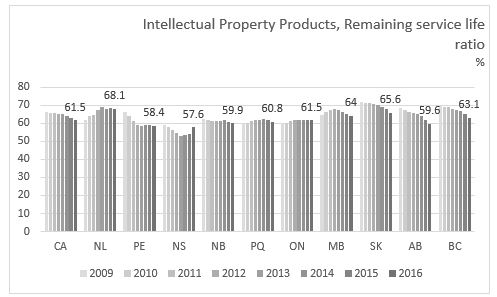
NOVA SCOTIA
The remaining useful service life ratio of buildings in Nova Scotia was 61.9 per cent in 2016, an increase from 60.1 per cent in 2009. The ratio has increased for industrial buildings, other commercial buildings, and schools, colleges and universities since 2009. 
The remaining useful service life for engineering structures in Nova Scotia declined 0.5 percentage points in 2016 to 57.3 per cent and has decreased by 2.0 percentage points since 2009. Aging assets in the oil and gas and other transportation categories have offset improved remaining service life ratios in highways/roads, electric power, waterworks engineering, and other engineering construction. Since 2014, there has been an increase in the mining engineering construction remaining service life ratio of 8.4 percentage points.
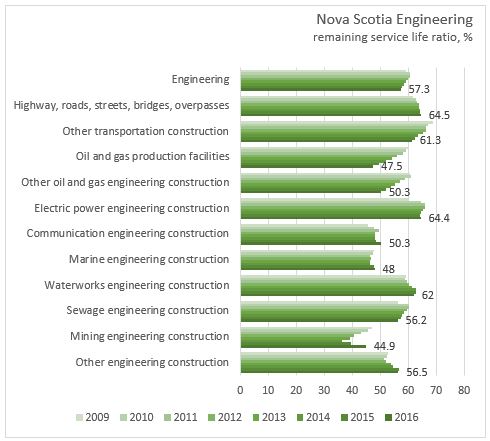
The remaining useful service life for machinery and equipment was up 1.1 percentage points to 53.8 per cent in 2016. For 2016, there were increases in the ratio of remaining service life for plastic and rubber products and wood products. The ratio for transportation equipment has risen steadily since 2009.
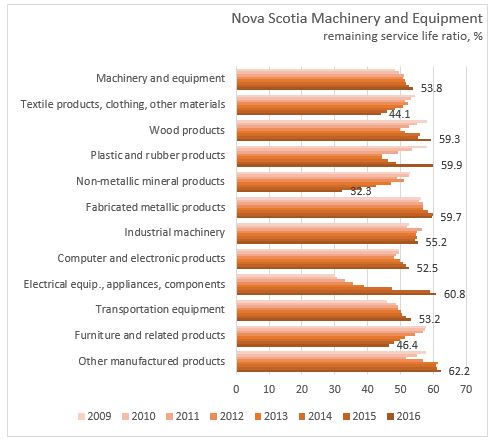
The remaining useful service life ratio for intellectual property products in Nova Scotia was up in 2016 by 3.4 percentage points due to an increase in mineral exploration and evaluation (+4.5 pp) while the ratios for research and development and software were both up 0.3 percentage points.

In terms of the non-residential capital stock by sector, the highest remaining useful service life ratios are found in the non-profit sector (79.4%), health care and social assistance (74.7%), administration and support services (66.9%) and professional, scientific and technical services (65.9%).
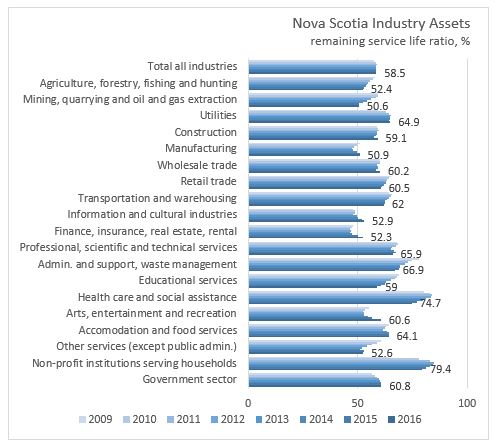
Statistics Canada: Remaining useful service life ratios of non-residential capital stock, 2016
<--- Return to Archive